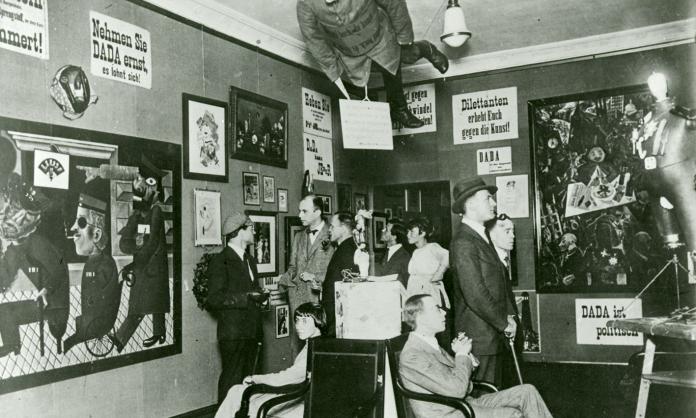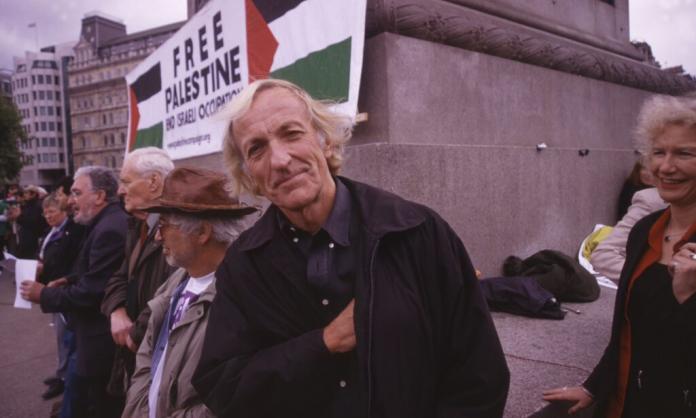“We took an oath of friendship”, wrote French poet, writer and performer Tristan Tzara in his account of the origins of Dadaism, “on the new transmutation that signifies nothing, and was the most formidable protest, the most intense armed affirmation of salvation liberty blasphemy mass combat speed prayer tranquillity private guerrilla negation and chocolate of the desperate”. Today, unfortunately, Dadaism has suffered the ultimate fate of all major aesthetic movements under capitalism. It is entirely defanged—its products languishing in galleries or being traded as luxury commodities on the global art market. At the time of its first emergence, however, things were very different.
Dadaism was born in February 1916 at the Cabaret Voltaire in Zurich. Located on the corner of the same narrow laneway in which the Russian revolutionary leader Vladimir Lenin was living at the time, it was conceived as a space for artists and performers who had fled various parts of Europe to find sanctuary from World War I in neutral Switzerland to come together and share their work. Each night there would be a program of events, including exhibitions, spoken word poetry, dance, theatre and music. The nights were rowdy affairs, the room lost in a cloud of smoke. It was here that the distinctive performative element of Dadaism was first established.
There is some debate about the origins of the word “Dada” itself. Most of the evidence points to its being randomly chosen from a French-German dictionary by the German writer and poet Richard Huelsenbeck one afternoon at Cabaret Voltaire co-founder Hugo Ball’s Zurich flat. In a diary entry from 18 April 1916, Ball recorded that “Dada is ‘yes, yes’ in Rumanian, ‘rocking horse’ and ‘hobbyhorse’ in French. For Germans it is a sign of foolish naivete, joy in procreation, and preoccupation with the baby carriage”. Huelsenbeck himself recounted that the two were most taken by its infantile sound and the association with their idea of “beginning at zero”.
Many of the artists who went on to form the core of the Dadaist movement were highly critical of the war. Some had direct experience of the horrors of trench warfare, and subsequently used their art to try to convey the reality that the government and the military worked so hard to sanitise. Perhaps most famous in this regard is the series of 51 prints titled Der Krieg (war) released by Otto Dix in 1924—works such as “Stormtroops Advancing Under Gas Attack” and “Wounded Soldier”.
The Dadaists, however, were far from believing in the efficacy of politely advocating for peace. “Beginning at zero” meant, to them, an attempt to smash through the norms and traditions of prewar high culture—which they saw as having contributed to the descent into the horror of industrial-scale slaughter in the trenches—and tap into the primordial levels of human experience and consciousness they hoped would lay the basis for a new humanity and a new world.
The culture of prewar Europe—on the surface so civilised and refined—had revealed itself as a monster. Its spirit, as the Dadaists saw it, is perhaps best captured in Raoul Hausmann’s work “Mechanical Head”: a stupid, blankly staring face devoid of any hint of humanity, with various instruments of measurement and mechanical contraptions glued to the skull. It’s a dystopian vision of modern life as empty and soulless, driven by external forces that could be neither controlled nor understood. “For the first time in history”, Richard Huelsenbeck wrote, “the consequence has been drawn from the question: What is German culture? (Answer: Shit), and this culture is attacked with all the instruments of satire, bluff, irony and finally, violence”.
Dadaism was, above all, characterised by its aggression. It was an assault on the senses that aimed, as Hans Arp put it, to “jolt people out of their wretched consciousness”. The Dadaists didn’t just want to shock their audiences—they wanted to shake them to the core of their being. In his famous essay “The Work of Art in the Age of Mechanical Reproduction”, Walter Benjamin put it like this: “From an alluring appearance or persuasive structure of sound the work of art of the Dadaists became an instrument of ballistics. It hit the spectator like a bullet, it happened to him, thus acquiring a tactile quality”. On a number of occasions, both in Zurich and later in Berlin, the Dadaists managed to provoke to the point where they were physically attacked by their audiences, arrested by the police, or both.
High art had traditionally sought to elevate its audience—to transport them away from everyday reality to a more refined realm of ideas, feelings and sensations. This kind of art was seen by the Dadaists as a more or less conscious contribution to the maintenance of the power of the elites and their pursuit of the war. German artist George Grosz described Dadaism as a response to “the cloud-wandering tendencies of so-called sacred art which found meaning in cubes and the gothic, while the field commanders painted in blood”.
“The highest art”, Huelsenbeck wrote in the Dada Manifesto of 1918, “will be one in which the thousandfold issues of the day are revealed in its consciousness, an art which allows itself to be noticeably shattered by last week’s explosions, which is forever trying to collect itself after the shock of recent days”. The Dadaists used, in their art, cut-up newspaper headlines, pictures from popular magazines, scraps of leaflets, political caricatures, advertising brochures, pieces of scrap metal and so on—all aimed at the jolt of recognition of a world gone mad.
Montage, perhaps the most well-known of the Dadaists’ aesthetic innovations, had particular potency in this regard. The origins of the technique are a bit obscure. One account has it that it started with artists including John Heartfield and George Grosz sending postcards with anti-war messages to soldiers at the front. The artists cut up and glued together pictures and words that would get the message across without attracting the attention of the military censors.
Whatever its origins, the montage technique was perfectly suited to the tasks of art as the Dadaists saw it. Here were the language and imagery of everyday life, cut from their contexts as part of mass media and propaganda, and reassembled in a way that reflected the chaotic, contradictory and violent reality of a society tearing itself apart in war and revolution.
It was in Berlin, rather than Zurich, that Dadaism ultimately found its main home (Australian art critic Robert Hughes is right in his assessment that “Paris Dada is mere froth and capering beside its German equivalent”). The Cabaret Voltaire closed its doors after only a few months, as much as anything else because the organisers were worn out by the frenetic pace of partying. But by that point the potency of Dadaism as a unifying symbol of aesthetic revolt against the barbarism of the time was clear. And nowhere was this more the case than in Berlin.
Dadaism was brought to Berlin by Huelsenbeck, who moved there from Zurich in January 1917. Huelsenbeck gathered around him a core group of anti-war artists and writers including John Heartfield and his brother Wieland Herzfelde, George Grosz, Erwin Piscator, Walter Mehring, Raoul Hausmann, Franz Jung and Hannah Höch. Early in 1918, the Dadaists began a series of evening events—readings, lectures, performances—on the model of the Cabaret Voltaire.
At the time Berlin was crushed under the boot of what was in effect a military dictatorship. Everyone was expected to play their part in the war effort. Even the slightest hint of resistance was severely punished. For a group of artists to appear on the scene under the banner of “Dada” was enough, in itself, to arouse suspicions. What did the word even mean?
The Dadaists were well aware of its potential to scandalise and draw a crowd to their events. They produced stickers with slogans like “Dada siegt!” (Dada wins) and “Dada, Dada über alles!”, a play on the famous “Deutschlandlied” that was later adopted as the German national anthem. The stickers found their way into office staircases, cafe toilets and even police stations. This, combined with the raucous and provocative nature of their performances, was enough for the movement to become something of a media sensation. There was even talk of a Dadaist conspiracy—one of the few times in history, perhaps, when the pretension of a small group of artists to pose a threat to the powers that be has been taken seriously.
By 1918 there was a growing sense that the old order was marching towards its own destruction. The harshness of military rule ensured that the appearance of order could be maintained. However, as the outbreak of mass strikes in Berlin and other centres in January 1918 showed, beneath the surface anger was seething.
In November 1918 Germany exploded in revolution. It began with sailors in Kiel refusing to put to sea in a mission that meant almost certain death. From there the mutiny spread across the north coast, and was carried inland along the railway lines by soldiers. Workers across the country downed tools and joined the revolt on the streets. Workers’ councils, on the model of the Russian soviets, which had come to power in October 1917, sprang up everywhere. Within a few days the entire country was in uproar. The German military commanders had no choice but to negotiate for peace.
The once imposing edifice of the old imperial order came crashing down, Kaiser Wilhelm abdicating on 9 November. Scared witless, and desperate to wrest back whatever control they could from the insurgent workers’ movement, the German capitalist class united behind the reformist Social Democratic Party (the SPD) and its leader Friedrich Ebert, who promised to restore order.
The Dadaists shared in the euphoria of the initial revolutionary wave that brought an end to the war. But their enthusiasm was short-lived. Through the course of November and December 1918, it became clear that the aims of the revolution were far from being achieved.
The German economy had been devastated. Unemployment, poverty and hunger raged. The streets overflowed with demobilised soldiers, war-wounded and beggars. In Huelsenbeck’s words, Berlin was a “city of tightened stomachers, of mounting, thundering hunger, where hidden rage was transformed into a boundless money lust, and men’s minds were concentrating more and more on questions of naked existence”. The radicalisation of workers continued. Having succeeded in overthrowing the old regime, workers began to demand full control of society, as in Soviet Russia.
The SPD claimed to be for a peaceful, democratic transition to socialism. In reality, however, its aim was to maintain as much of the old order as possible. To the demand for all power to the workers’ councils, they counterposed elections to the National Assembly, planned for January 1919. To maintain their position in the face of the challenge from the workers’ movement, they relied increasingly on the most reactionary remnants of the old regime. In this context the SPD’s Gustav Noske set about organising the Freikorps. These were armed bands made up, for the most part, of former officers in the imperial army.
An uprising of militant workers and soldiers in early January provided a first test of strength. The SPD blamed the uprising on the leaders of the newly formed German Communist Party (KPD)—particularly Rosa Luxemburg and Karl Liebknecht. Noske called in the Freikorps to drown the uprising in blood. Workers who had been occupying the building of the main SPD newspaper Vorwärts were executed on the spot. Luxemburg and Liebknecht were captured and killed.
In the weeks and months that followed, the reaction gained momentum. Confronted with ongoing strikes and uprisings by workers, the Freikorps set off on a march of terror across Germany. A student member of the Freikorps gave the following account of an operation in the Ruhr valley: “No pardon is given. We shoot even the wounded. The enthusiasm is terrific—unbelievable ... Anyone who falls into our hands first gets the rifle butt and then is finished off with a bullet”.
The Dadaists were quick to see through the SPD leaders’ claim to be leading a transition to socialism. A number of them, notably John Heartfield, Wieland Herzfelde and George Grosz, signed up to the KPD during its founding conference at the end of December 1918.
The first initiative the Dadaists undertook following the murder of Luxemburg and Liebknecht was the publication of a satirical magazine. Jedermann Sein Eigner Fussball—which translates as “Everyone their own football”—appeared on 15 February, a week after the first gathering of the National Assembly of the Weimar Republic. Jedermann was the brainchild of Wieland Herzfelde, who conceived it as “a new periodical of literary, artistic and political character, brought out at irregular intervals, cheap ... [with a] newspaper-style make-up”. The intention was, as he put it, to “sling mud at everything the Germans have so far held dear”.
The cover was a finely calibrated parody of the layout of the numerous conservative pictorial journals that had emerged during the war. The title alludes to the reputed promise of 16th century French King Henry IV that peasants would enjoy “a chicken in the pot every Sunday”. It was meant, it seems, as a sarcastic reference to the kind of paltry “reforms” being offered by the SPD-led government in an attempt to face off the demand for workers’ power.
The main cover image, a photo-montage created by Grosz, shows a fan, onto which has been pasted portraits of members of the SPD government, along with Independent Social Democratic Party leader Karl Kautsky and General Erich Ludendorff, leader of the German imperial army. The headline reads “Gallery of German male beauty: Prize Question! Who is most beautiful?”. This was an ironic reference to the opening of the National Assembly a week earlier, and the facile nature of the political spectacle it created in the context of the class struggle raging across Germany at the time.
The remaining three pages of Jedermann contained cartoons by Grosz, poetry and polemics against the military and the government. Perhaps the most interesting aspect of it, though, is the way they went about distribution. On 17 February 1919, the six-person editorial team set out with 7,600 copies in a mock funeral procession across Berlin. Dressed in frock coats and top hats, and riding in a horse-drawn carriage, they were preceded by a small band playing sentimental military tunes. Their friends and contributors to Jedermann walked behind distributing the paper as they went.
Their procession began in the more affluent western suburbs, where they were mostly greeted with taunts and threats. However, by the time they got to the working-class districts in the east, they were received with delight. The procession was joined by thousands of others and became a spontaneous protest march. The crowd was dispersed by police as it approached Alexanderplatz, by which point the entire run of 7,600 copies had been sold out.
Jedermann was immediately banned. But its success encouraged the Dadaists to try again. A few weeks later they brought out a new publication under the title of Die Pleite, or “bankruptcy”. The cover depicted SPD leader and newly elected German President Friedrich Ebert as king, accompanied by the words “by the grace of moneybags”—a play on the idea of the kaiser ruling “by the grace of God”. Pride of place in this issue went, significantly, to the Russian Soviet government’s invitation to the First Congress of the Communist International. Die Pleite grew to a print run of 10,000 to 12,000 copies before, in January 1920, the government succeeded in suppressing it.
The next high-profile event organised by the Dadaists in Berlin, and perhaps the single most important event in the history of the Dada movement internationally, was the First International Dada Fair—held from 30 June to 25 August 1920. The fair brought together the largest collection of works by German Dadaists that had been assembled to that point.
Hanging from the roof of the main exhibition room was John Heartfield and Rudolf Schlichter’s work “Prussian Archangel”. This giant puppet featured a pig’s head attached to a German military officer’s uniform, around which was wrapped a poster reading “I come from Heaven, from Heaven on high”. Below this was hung a sign with the text reading “In order to understand this work of art completely, one should drill daily for twelve hours with a heavy backpack in full marching order on the Tempelhofer field”. The authorities didn’t see the joke—and subsequently charged Heartfield and Schlichter with defaming the German army.
In Hannah Höch’s Dada-Rundschau, or “Dada Panorama”, Friedrich Ebert appears alongside Minister of Defence Gustav Noske—cut out from a notorious picture of the two of them standing in their bathing suits in a lake, which had appeared in the popular Berliner Illustrirte Zeitung in August 1919. The rest of the montage is taken up by cuttings of photographs from reactionary demonstrations, street-fighting involving revolutionary workers and various figures from military and political life.
A couple of details indicate the meaning. Ebert and Noske are presented as political innocents, highlighted by the casualness of their attire, their carefree demeanour and the added detail of flowers stuffed down the front of their bathing shorts. However, in place of Ebert’s lower legs and feet, Höch cut in a pair of shiny military boots. Where Noske’s legs should be is a cloud of smoke or dust, as if from an explosion.
Again, this comes back to the question of political appearance and reality in the early years of Weimar. Ebert, Noske and the rest of the SPD leaders liked to present themselves as guileless practical politicians—getting on with the job of rebuilding society and maintaining order and stability in the face of excesses on the left and the right. The reality was, however, that the bloated body of the SPD was, during this period, the main patron of the reactionaries and a bulwark against any further advance by the workers. The threat of violence—symbolised by the military boots and the explosion—was never far from the surface. The terror of the Freikorps could be unleashed at any time on those who dared to push for more radical change.
In terms of the turnout to the exhibition, the Dada Fair was a failure. Between 16 July and 4 August, only around 80 tickets were sold—approximately four a day. But when it came to Dadaism’s renown in the global art world, it was a breakthrough success. The organisers hired a professional photographer to take a series of photos of the exhibition opening. The photos were subsequently picked up by newspapers and journals around the world—eager for anything resembling sensational news of decadence and disorder in postwar Germany. Articles and reviews appeared in the media in Paris, Milan, London and New York, among other centres.
This was the moment at which Dada began its ascent into the mainstream of the art world. Perhaps appropriately, it also signalled the beginning of the end of Dadaism in Berlin as anything resembling a coherent art movement. In the following years, the artists who had made up the core of the Dada scene between 1917 and 1920 began moving in different directions. For the likes of Heartfield and Grosz, this was towards a further integration into the work of the KPD. For others, it was towards the New Objectivity and other cultural trends of the Weimar period.
Of course the influence of, and interest in, Dadaism in Germany and elsewhere didn’t end there. Dadaism, itself a product of the collapse of European society into the barbarity of World War I, went on to become among the biggest influences on European culture throughout the 1920s. Some of the main things people associate with Weimar Berlin—from cabaret, to Bauhaus, to Brechtianism and beyond—should be counted among the cultural phenomena the Dada movement more or less directly sparked.
What can the example of the Berlin Dadaists tell us about art and revolution (and the art of revolution) today? At times they came close to advocating an unambiguously anti-art position. In early 1920, Heartfield and Grosz wrote the essay “Der Kunstlump” (or “Art Scoundrel”) in response to a widely published appeal by expressionist artist Oskar Kokoschka against the damage done to a Rubens painting that was hit by a stray bullet during a street battle in Dresden.
“We greet with pleasure”, Heartfield and Grosz wrote, “the fact that bullets whiz into the galleries and palaces, into the masterpieces of Rubens, instead of into the homes of the poor in the workers’ districts”. As they saw it, in the context of the ongoing revolutionary struggle, “the cleaning of a gun by a Red soldier is of greater significance than the entire metaphysical output of all the painters”. As if that wasn’t enough to make the point, another (by this time former) Dadaist, Otto Dix, subsequently included a not-so-subtle reference to the debate in his work “The Matchbox Seller I”—which shows a disabled war veteran selling matches on the street, as well as an actual copy of Kokoschka’s appeal, glued to the canvas, lying in the gutter absorbing the stream trickling down from a pissing dachshund. Art, the message was, will never be as important as the actual, living struggles of human beings.
Looking at the state of the world today, and the corresponding state of the so-called “art world”, it might be tempting to adopt the same intransigent stance. Isn’t art just a frivolous distraction from the more urgent task of tackling the multiple crises—economic, social and environmental—that are raging all around us?
Art, however, isn’t something we can, or should, put aside to focus on the (undoubtedly very urgent) need for revolution. The kind of genuinely free and creative labour that occurs in the production of art is—as Marx himself makes clear in his 1844 Manuscripts—a central part of what makes us human. Even under capitalism, where genuine creativity is pushed to the margins by the relentless drive to profit, art, in its many forms, can provide us at the very least with some solace, and at best can be a powerful spur to action.
The example of the Dadaists is instructive. Despite their sometimes stridently anti-art rhetoric, their weapon of choice throughout Germany’s revolutionary years remained the brush and the pen. They weren’t really anti-art as such, but rather against the kind of art that sees itself as standing outside or above society—passing judgment from on high or transporting people away from the challenges and contradictions of everyday life. To the extent that art is a living part of society, rather than a setting for the pantomime of empty luxury that constitutes everyday life for the super-rich, it’s where it’s situated within the struggles of workers and the oppressed. The Dadaists provide us with an example of what this looks like in practice.
In an essay from 1925 titled “Art is in danger”, George Grosz wrote that, in the context of a capitalist society in which the drive to profit trumps any other concern, if they aren’t content simply to be irrelevant, artists face a choice: “Either they join the ranks of architects, engineers, and advertisers who develop industrial strength and who exploit the world, or, as depicter and critic of the face of our time, as propagandist and defender of the revolutionary idea and its followers, they enter into the army of the oppressed who fight for their share of the worth of the world and for a sensible social organisation of life”.
The challenge for artists and art lovers remains, today, to rescue art from the auction houses, boardrooms and stuffy soirees of the rich, and to bring it back to the streets, where it belongs.











